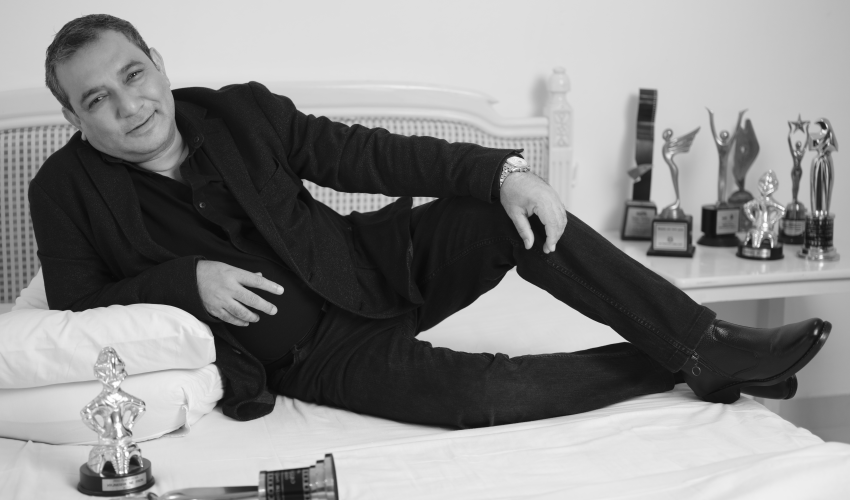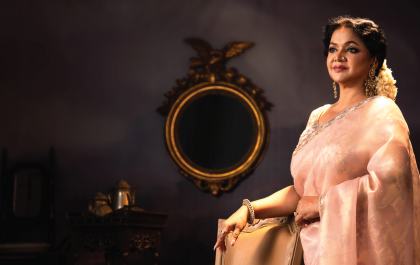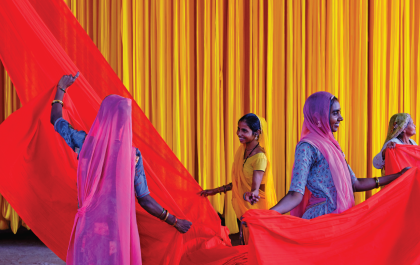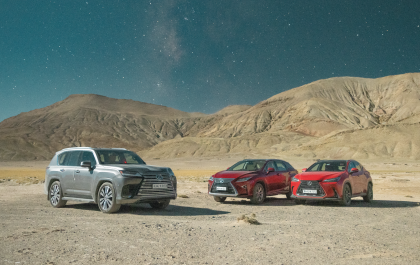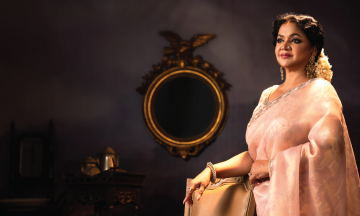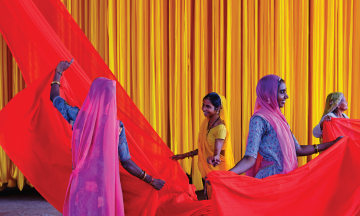It is impossible to imagine the entertainment scene in the 80s and 90s without the name of Tauqir Ahmed being mentioned. A familiar face on stage and in the silver screen, he was everyone’s favorite romantic lead. When his onscreen chemistry with co-star Bipasha Hayat translated to a real-life romance, culminating in marriage, it was the perfect fairytale for their fans. Tauqir Ahmed has remained a fixture in our psyche with his directorial ventures as well, and his recent role as Huseyn Shaheed Suhrawardy in the hugely popular Mujib biopic has been a much-anticipated revival.
By Ayman Anika
An architect, actor, director, and writer, the multi-talented persona Tauqir Ahmed is a man who wears many hats. A luminary presence in the Bangladeshi film industry, he has etched his name in the annals of showbiz and theatre alike. Truly, his name resonates with artistic brilliance and has sculpted a multifaceted career that transcends the boundaries of conventional story-telling.
After completing studies at the prestigious Jhenaidah Cadet College and Bangladesh University of Engineering and Technology (BUET), he ventured into the world of theatre where Ekushey Padak laureates Ramendu Majumdar and Abdullah Al Mamun shaped Tauqir Ahmed’s artistic journey. After that, he didn’t have to look back.
From the romantic lead on screen to the visionary director behind the camera, Ahmed’s story is a narrative woven with threads of creativity, perseverance, and an unwavering commitment to the craft.

Tauqir Ahmed’s tryst with the silver screen began with a captivating lead role in romantic narratives, laying the foundation for a career that would evolve into a mesmerizing saga of cinematic excellence. As an actor, Ahmed breathed life into characters, creating an emotional resonance that captivated audiences.
However, Ahmed’s narrative prowess wasn’t confined to acting alone. Venturing into the directorial realm, he wielded the filmmaker’s brush with finesse. His directorial ventures weren’t just movies; they were canvases painted with narratives that transcended the ordinary, delving deep into the intricacies of the human experience. Films Joyjatra (2004) and Oggatonama (2016) brought him the Bangladesh National Film Awards and his directorial Daruchini Dip won the hearts of younger generations and his telefilm Roopkathar Golpo (2006) brought him praise. His ability to infuse authenticity into narratives struck a chord with audiences far beyond the borders of Bangladesh – just think about the masterpiece Haldaa (2017)!
But Tauqir Ahmed is not merely a cinematic virtuoso; he is a creative alchemist. His foray into collaborative projects showcased not just his story-telling prowess but also his ability to ignite sparks of creativity in those around him. His diverse skill set, ranging from intellectual creativity to construction management, which is reflected in his architectural creation Nokkhottrobari, paints a portrait of a creative polymath navigating the intersections of art and innovation.
So, to get a peek into the mind of this cinematic maestro and know the ins and outs of his creative journey, MWB engaged in a candid conversation with Tauqir Ahmed.
You have been switching between living in Bangladesh and the United States. So, how do you balance your personal and professional life, considering the demands of the entertainment industry?
Living in two different countries has its challenges, especially with the demanding nature of the entertainment industry. But I try my best to maintain a balance between my personal and professional life. Though I have been travelling between the United States and Bangladesh, I have been persistent about my work. My theatre play Tirthojatri (Pilgrims) was showcased in New York recently. In Bangladesh, Tirthojatri has been performed by Natyakendra. So, I devoted 2023 to theatre performances.

My wife Bipasha and I always try to enjoy our family life. We have two children and everyone is busy with their work. But in the end, it’s all about finding harmony and staying connected with loved ones, no matter the physical distance. In the USA, I don’t have a 9 to 5 job. So, I devote my time to my artistic preparation – whether it is reading books, listening to music, or watching good films.
Do you have any fond childhood memories or any memorable experiences that you would like to share with us?
My father died early, and I was the fourth one among the five of my siblings. Still, I was not exempt from taking over the responsibilities as I had to worry about my two sisters, and my brother was in military service.
Yes, though I had to start when I was very young, this experience and hardship gave me vision, courage, and experience. At that age, when other young people were enjoying their lives, I learned to be independent and see the positive as well as negative sides of any situation. In all honesty, my childhood laid the foundation for who I am today.
You are an accomplished architect. What inspired you to transition from architecture to the world of cinema and acting?
Architecture is an all-rounded subject and it requires creativity. When someone goes to study architecture, they need to learn about psychology as well as sculpture or fine arts. While I was studying architecture, I got involved with theatre and consequently, Ramendu Da and Abdullah Al Mamun became my teachers.
Later, I received training at prestigious academies such as the Royal Court Theatre, England in 1995, the University of Theatre of Nations, South Korea in 1989, and the New York Film Academy in 2002, which solidified my love for arts and theatre.

At one point, I was devoting more time to theatre than my studies. I was young and I was enjoying it wholeheartedly. My enjoyment became my passion eventually. If someone asked me what would be my choice between architecture and acting, my answer would be definitely acting.
Can you tell us about your recent project as an architect? Do you have any special memory associated with it?
I am not involved with architecture anymore and Nokkhottrobari was my last project. But the knowledge I have gained from my life as an architect has helped in every step of the way.
Nokkhottrobari Resort is one of my pioneering projects. My vision was to create a project, which would be an escape to a completely different world – relaxing, artistic, and a cultural center. Nokkhottrobari Resort embodies this concept. It is environmentally friendly and at the same time, visually pleasing.

It is blended with nature and the space is designed to bring people close to nature and suitable for outdoor activities. People still visit the resort on many occasions and enjoy their time here.
Your recent project, Tirthojatri marks your theatrical comeback. What motivated you to return to the theatre, and how was the experience different from your work in cinema?
I work in multiple disciplines and writing for theatre is one of my fortes. I have a few publications. Many people don’t know that I wrote Oggatonama as a play. Similarly, in 2002, my play Iccha Mrito was showcased in New York. Moreover, I directed Girish Karnad’s Haybadan in 1995 and in 2003, I wrote and directed Protisharan in 2003.
Tirthojatri is based on a book by Humayun Kabir and later, we turned it into a play. I have an unending love for theatre and as I work in many disciplines, I don’t get to invest much time in it.
So, I would say returning to theatre with Tirthojatri was driven by a desire to reconnect with the raw and immediate energy of live performances. The experience is always different from cinema, offering a unique interaction with the audience and a refreshing challenge for an actor.
Whenever I feel that I need to come to the theatre, I never ignore this call. When Tirthojatri was first premiered in New York, the play was well-appreciated by everyone. So, I felt like why not offer it to the audience in Bangladesh?
After returning to Bangladesh, I opened a theatre camp and conducted training sessions for two months to prepare for Tirthojatri. Hopefully, next month (in December) Tirthojatri will be showcased again.

I believe working in theatre is not easy. It requires much training and dedication to perform in a theatre play. You may find many actors, poets, and directors. But how many playwrights will you find? Very few. This is the beauty of theatre.
Now, let’s talk about your role as Suhrawardy in the Bangabandhu biopic Mujib, which garnered attention and praise from the audience. What attracted you to this project?
The story of Bangabandhu Sheikh Mujibur Rahman is a crucial part of our history, and the opportunity to portray Suhrawardy in Mujib was very persuasive. I believe it is not only me, but everyone was eager to be a part of this project and the chance to contribute to such an anticipated movie has been a huge opportunity for me.
Firstly, the historical significance of Suhrawardy’s role in shaping the narrative of Bangladesh intrigued me. His pivotal role in the nation’s liberation movement and his interactions with Sheikh Mujibur Rahman presented a compelling and nuanced character study.
Moreover, the script’s depth and the director’s vision were pivotal factors. The narrative didn’t merely skim the surface; it delved into the intricacies of Suhrawardy’s life, offering an opportunity to unravel layers of a historical figure often overshadowed.
I was first considered to portray the role of Tajuddin Ahmad. Then the director decided I would be a better fit for the Suhrawardy character in the movie.
Essentially, Mujib is not just another biopic; it was a cultural odyssey, and the prospect of being part of such a significant cinematic venture, immortalizing a pivotal historical figure, was an offer I couldn’t resist. I also wanted to see how these big-budget productions are conducted, so this opportunity equally pulled me to this movie.
How did you prepare for this significant character and what did it mean to you to portray him?
In terms of fiction films, I envision the characters in my mind. However, when it comes to biopics, the characters are real, their lives are real, and I need to portray them from reality. So, it requires a different kind of preparation.
For me, acting is portraying someone – holding that person’s soul in me – and depicting the essence of that very character. I tried to apply the same notion to the Suhrawardy character in Mujib.

To breathe life into this significant character, Huseyn Shaheed Suhrawardy, I delved into extensive research on Suhrawardy’s life, studying historical records, literature, and first-hand accounts. Understanding the nuances of his persona, political influence, and pivotal role in shaping Bangladesh’s history was paramount.
I collaborated closely with the director, Shyam Benegal, and the casting director, Shyam Rawat, to ensure an authentic representation. Engaging in detailed discussions and workshops allowed me to grasp the subtleties of Suhrawardy’s character, capturing not just his external demeanor but also the essence of his convictions and struggles.
I tried to bring unique flavor into the character on my own accord. For example, Suhrawardy couldn’t speak Bangla, so I tried to mimic his style and spoke a little distorted Bangla. Again, he was a man of great appetite and loved to eat. But I also gained extra weight to make my character look realistic. I believe these little changes were quite evident throughout the film.
Tell us about your experience working with the esteemed director Shyam Benegal. Did you gain any valuable insight or learn something new?
When I heard about working with Shyam Benegal, I was naturally drawn to Mujib. Frankly, I was curious to see how these big-budget films work. Collaborating with Shyam Benegal was an enriching journey, akin to attending a masterclass in film-making. Benegal’s seasoned directorial prowess and insightful guidance created an environment that nurtured creativity and depth in our work.
After I was done with my first scene, he told me that I had hooked the character. It was a big compliment for me. He was happy with my work and gradually, the number of my scenes increased.
My collaboration with Shyam Benegal was not just a professional engagement but a transformative journey that deepened my appreciation for the art of story-telling and the nuanced craft of film-making.
Your career has included both acting and directing. How do these two roles complement each other in your creative journey?
As an actor, I have always been conscious of the responsibilities placed on my shoulders – whether I am doing justice to the character or portraying in the right way, or what will happen if the audience does not like my acting – these thoughts have occupied my mind.
As a director, I believe that the audience has the right to decide for himself/herself whether they like the movie or not; it largely varies from person to person. For instance, when I made Haldaa, some people liked it a lot and others took it as a mediocre film.
The symbiosis lies in the reciprocity of these roles. As an actor, I bring an intimate understanding of the actor’s craft to my directorial decisions. This empathy enhances communication with the cast, fostering an environment that nurtures authentic performances.
Conversely, my experience as a director informs my acting choices. It grants me a profound insight into the director’s perspective, allowing me to align my performance with the overarching vision of the project.
At the end of the day, it is up to the audience to decide. I cannot force anyone to like my films (both as an actor and director), rather I can only offer my works and innovation.

As a director, what do you believe makes a compelling historical film?
A well-crafted script with a compelling narrative structure would make any film a compelling one, but it depends on the taste or preference of the person watching the film.
You may not listen to Ustad Bismillah Khan’s shehnai but many people find it very compelling and soothing to the ear. Once I used to enjoy working in romantic drama but gradually my perception changed.
So, I wouldn’t say there is a secret recipe for making a compelling historical movie. Art has different shades and spheres and the audience sees with different lenses.
What impact do you hope Mujib will have on the audience, especially regarding historical awareness and cultural significance?
Mujib delivers historical lessons onscreen, shedding light on the cultural and historical context of the period. So, I believe it is a good opportunity to look back at history through the life of a great man.
But as Bangabandhu is a political figure, people might see it differently – some may like it, some may not. Nevertheless, I believe art will throw questions at you, it will provoke your mind and this is more important. We should be open to the thought that no art is absolute; it will impact different individuals differently.
Your films Joyjatra and Halda are certainly some of your well-known films. But Daruchini Dip has engraved a special place in our hearts – especially among today’s young generation. Can you share your memorable moments from working on these projects?
In reality, I was a bit sceptical about making this movie when I was first approached with the proposal. But eventually, I decided to make the film, which is based on Humayun Ahmed’s novel and I made it for the young people.
It gives immense joy to see that though I made it in 2007, it is still relevant today and people like the movie even now.
You played the role of a villain in Buker Moddhe Agun. Can you tell us what type of roles do you prefer?
When I was young used to be cast in romantic roles, mostly. But then, I did play a fewnegative roles to bring variations into my acting career. I think actors should try to break this prototype image. They shouldn’t limit themselves to only one type of character and this is why I played the role of a villain.
We must talk about you and Bipasha Hayat. You both are accomplished actors and have collaborated on various projects. Can you share what it’s like working together and how your professional partnership has evolved over the years?
When we used to work together, everyone liked our pair very much. Directors also preferred to cast us together. All through the 90s and beyond, we worked on many projects and stages. She had been my friend and our friendship evolved into our marriage.
I believe that mutual trust and friendship are the foundation of any marriage – Bipasha and I had these pillars in our relationship from the beginning. However, now that a long time has passed, Bipasha is more focused on painting and I am busy with my projects.

What genre of songs do you find most soothing?
I prefer to listen to soft melodies, and songs by John Denver as well as Adele.
What is your favorite book right now or of all time?
Currently, I am reading a book, it is called Sapiens: A Brief History of Humankind, a book by Yuval Noah Harari. I think it is a very well-written and insightful piece of work.
Could you tell us about any upcoming film projects or roles you’re excited about and what draws you to these particular projects?
I have many ideas written and scripted that I work on but as always, confirmation of funds is an issue. Filmmakers need funds to make movies. So, until I get the confirmation, I cannot say anything for sure.




